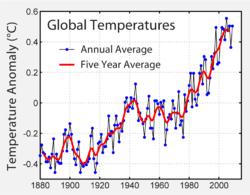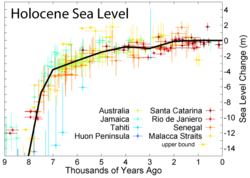From Wikipedia, the free encyclopedia
[edit] Description

Temperature changes during a similar period and possibly responsible for causing the observed sea level rise.

Sea level variations over the last nine thousand years
This figure shows the change in annually averaged sea level at 23 geologically stable tide gauge sites with long-term records as selected by Douglas (1997). The thick dark line is a three-year moving average of the instrumental records. This data indicates a sea level rise of ~18.5 cm from 1900-2000. Because of the limited geographic coverage of these records, it is not obvious whether the apparent decadal fluctuations represent true variations in global sea level or merely variations across regions that are not resolved.
For comparison, the recent annually averaged satellite altimetry data [1] from TOPEX/Poseidon are shown in red. These data indicate a somewhat higher rate of increase than tide gauge data, however the source of this discrepancy is not obvious. It may represent systematic error in the satellite record and/or incomplete geographic sampling in the tide gauge record. The month to month scatter on the satellite measurements is roughly the thickness of the plotted red curve.
Original data for this figure is from the Permanent Service for Mean Sea Level [2] (PSMSL). Douglas (1997), defined the following criteria for selecting records from the PSMSL which were long, reliable, and avoided large vertical geologic changes:
- Each record should be at least 60 years in length
- Not be located at collisional plate boundaries
- At least 80% complete
- Show reasonable agreement at low frequencies with nearby gauges sampling the same water mass
- Not be located in regions subject to large post-glacial rebound
He subsequently identified 24 PSMSL records meeting all five of these criteria:
- Auckland, 1903-2000
- Balboa, 1908-1996
- Brest, 1807-2000
- Buenos Aires, Argentina, 1905-1987
- Cascais, 1882-1993
- Cristobal, 1909-1980
- Dunedin, 1900-1998
- Fernandina, 1897-2003
- Genova, 1884-1997
- Honolulu, 1905-2003
- Key West, 1913-2003
- Lagos, 1908-1999
- La Jolla, 1924-2003
- Lyttelton, 1924-2000
- Marseille, 1885-2000
- Newlyn, Cornwall, 1915-2003
- Pensacola, 1923-2003
- Quequen, 1918-1982
- San Diego, 1906-2003
- San Francisco, 1854-2003
- Santa Cruz de Tenerife, 1927-1990
- Santa Monica, 1933-2003
- Trieste, 1905-2001
- Wellington, 1901-1988
After slight corrections following Douglas (1997) for any remaining post-glacial rebound at these sites (typically ~3 cm/century), the tide gauge data from these sites were plotted in no particular order as the thin lines in the above figure. One site, Wellington, was omitted because the author of this figure was unable to locate the corresponding record from the PSMSL.
[edit] Copyright
This figure was prepared from publicly available data by Robert A. Rohde and is incorporated into the Global Warming Art project.
Image from Global Warming Art
This image is an original work created for Global Warming Art.
Permission is granted to copy, distribute and/or modify this image under either:
Please refer to the image description page on Global Warming Art for more information
[edit] Reference
Bruce C. Douglas (1997). "Global Sea Rise: A Redetermination". Surveys in Geophysics 18: 279-292.
File history
Click on a date/time to view the file as it appeared at that time.
| Date/Time | Dimensions | User | Comment |
|---|
| current | 14:49, 26 December 2005 | 537×373 (47 KB) | Angrense | |
File links
The following pages on the English Wikipedia link to this file (pages on other projects are not listed):





